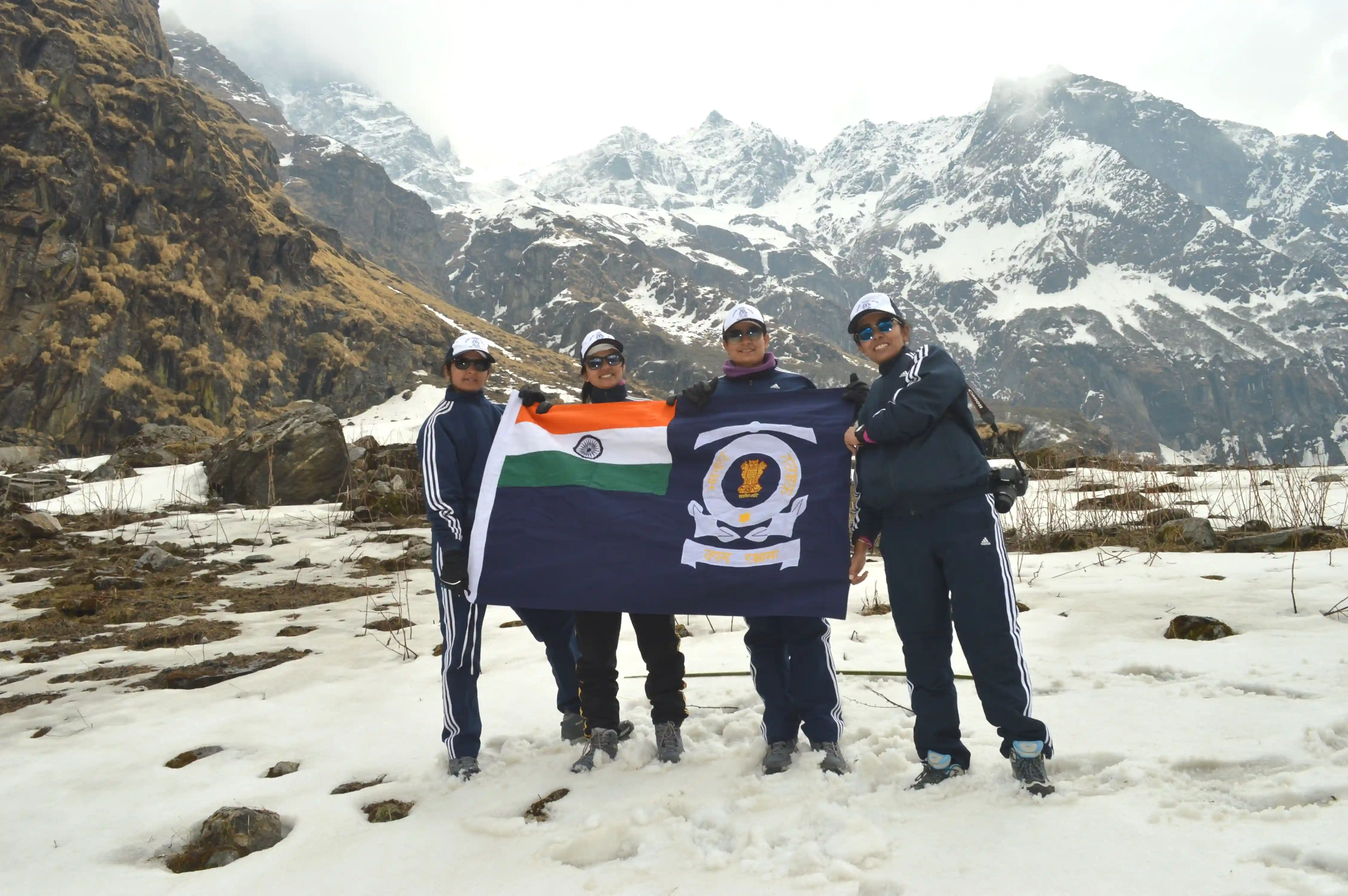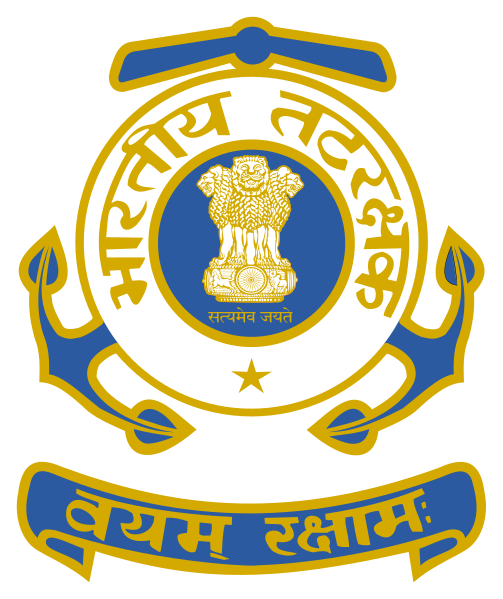Assistant Commandant (Women-SSA) - Female
Eligibility Criteria
| Type of Entry | Age | Educational Qualification | Medical Standard |
|---|---|---|---|
| Assistant Commandant General Duty (Women-SSA) | 21-25 years (5 Yrs relaxation for SC/ST and 3 Yrs for OBC) |
(i) Should hold a degree of recognized university with minimum 60% aggregate marks for General/OBC/EWS candidates and 55% aggregate for SC/ST candidates. (ii) Mathematics and Physics as subject upto Intermediate or class XII of 10+2+3 scheme of education or equivalent with minimum 55% aggregate marks in Mathematics and Physics.The candidates who have completed graduation after diploma, are also eligible, provided they should possess an aggregate of 55% marks in diploma with physics and mathematics in its curriculum. |
(a) Height: 152 cms.
(b) Weight: Proportionate to the height and age.
(c) Chest: well proportionate, minimum 5 cms expansion
(d) Eye Sight : |
Note:
- Candidates appeared in the final year or final semester exam and awaiting result are allowed to apply provided that they should not have any present back papers. Such candidates should be able to submit provisional or original degree certificate issued by the University only at the time of final selection board.
- In case the candidates are awarded grades/ CGPA instead of marks, the conversion of grades/ CGPA to percentage of marks would be based on the procedure certified by the University from where they have obtained the degree.
- Candidates withdrawn on disciplinary grounds from any other service training academy are not eligible to appear.
- Candidates should not have been arrested, convicted or prosecuted on criminal charges
- If there is no vacancy for SC/ST/OBC (Non-creamy)/EWS category candidates, in such case, reserved category candidates can still apply as unreserved, however, they will not be eligible for any age and passing marks concession/relaxation. SC/ST candidates will only be exempted from payment of application fee.
Syllabus
| Section No. | Section | Topic |
|---|---|---|
| Section 1 | English | Comprehension, Usage of Words, Sentence completion / Corrections, Punctuations, Grammar, Vocabulary, Antonyms and Synonyms, Parts of Speech, Direct and Indirect Speech, Idioms and Phrases, Active and Passive Voice.etc (Question paper will be designed to test the candidates understanding of English and workmanlike use of Grammar) |
| Section 2 | Reasoning and Numerical Ability | Spatial, Numerical, Reasoning and Associative Ability, Sequences, Spellings, Unscrambling, Coding and Decoding, Missing Numbers / Series Completion, Decimal Fraction, Ratios and Proportion, Average and Volume, Time and Work, Speed and Distance, Market Price, Cash Price, Expenditure Problems, Profit and Loss, Percentage, Factoring (LCM and HCF), Simple Interest and Compound Interest, Mensuration Formulas (Calculation of length, breadth or height of square, rectangle, cube etc) |
| Section 3 | General Science and Mathematical Aptitude | Nature of Matter, Universe, Electricity and its Applications, Force and Gravitation, Newton’s Laws of Motion, Work, Energy and Power, Heat, Temperature, Light, Current, Magnetism, Metals and Non Metals, Measurements, Sound and Wave Motion, Atomic Structure, Chemistry – Carbon and its Compounds, Periodic Table, Acids, Bases & Salts, Food, Nutrition and Health Physiology and Human Diseases and Basic Computer Science Arithmetic Ability, Number Systems, Algebra, Basic Trigonometry, Geometry, Statistics, Probability and Set Theory. |
| Section 4 | General Knowledge | History of India, Geography, Climate / Environment, Civics – Constitution of India, Art, Culture, Dance, Heritage, Religion, Freedom Movement, Important National Facts, Economics, Politics, Sports and Championships, Entertainment, Books and Authors, Awards, Defence and Wars, Geographical Neighbours, Countries – Languages, Capitals, Currencies, Common Name, Full Forms, Abbreviations, Eminent Personalities, National – Bird/ Animal/ Monuments/ Flower/ Anthem/ Sport/ Flag/ Emblem etc, Discoveries and Current Affairs. |
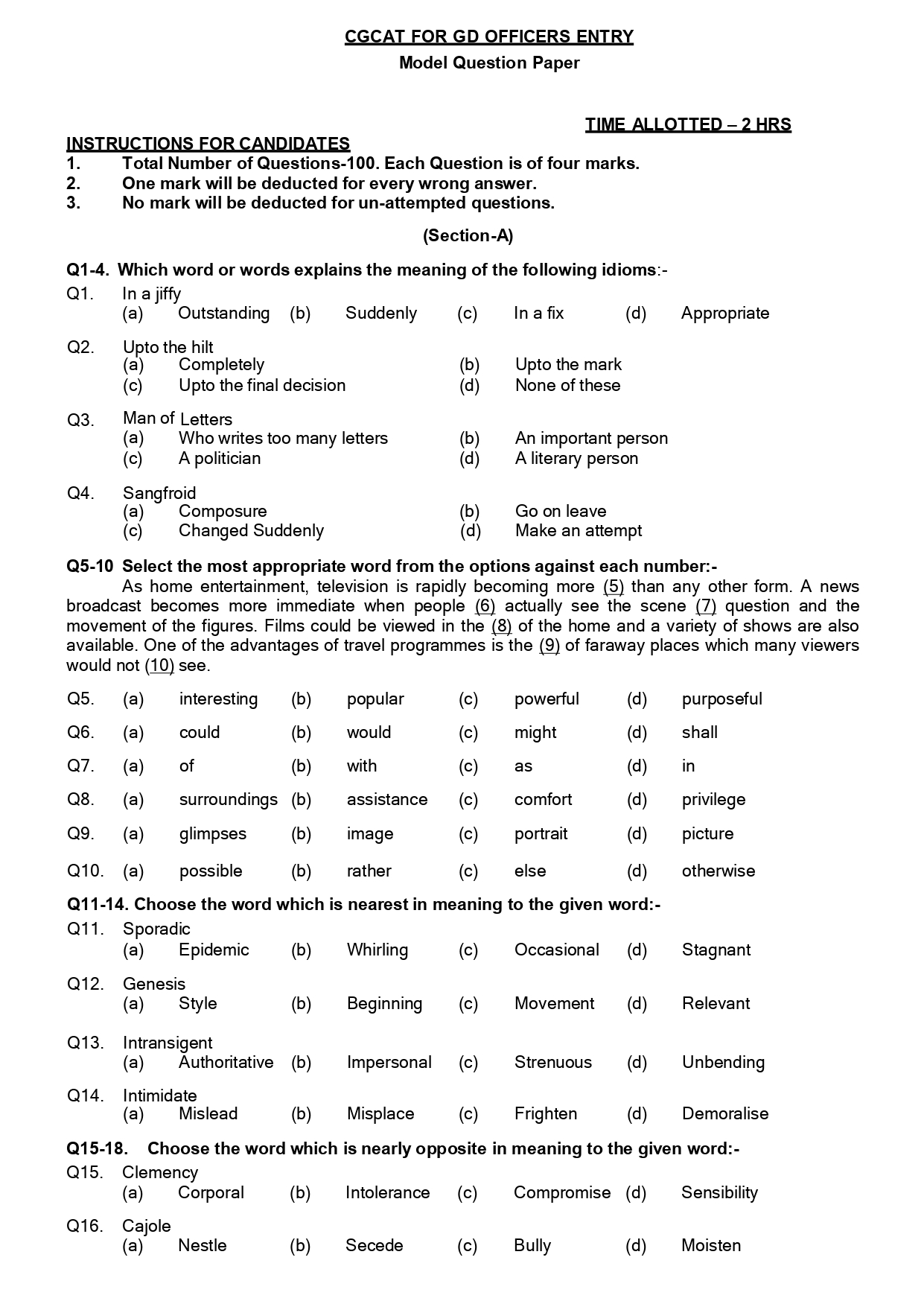
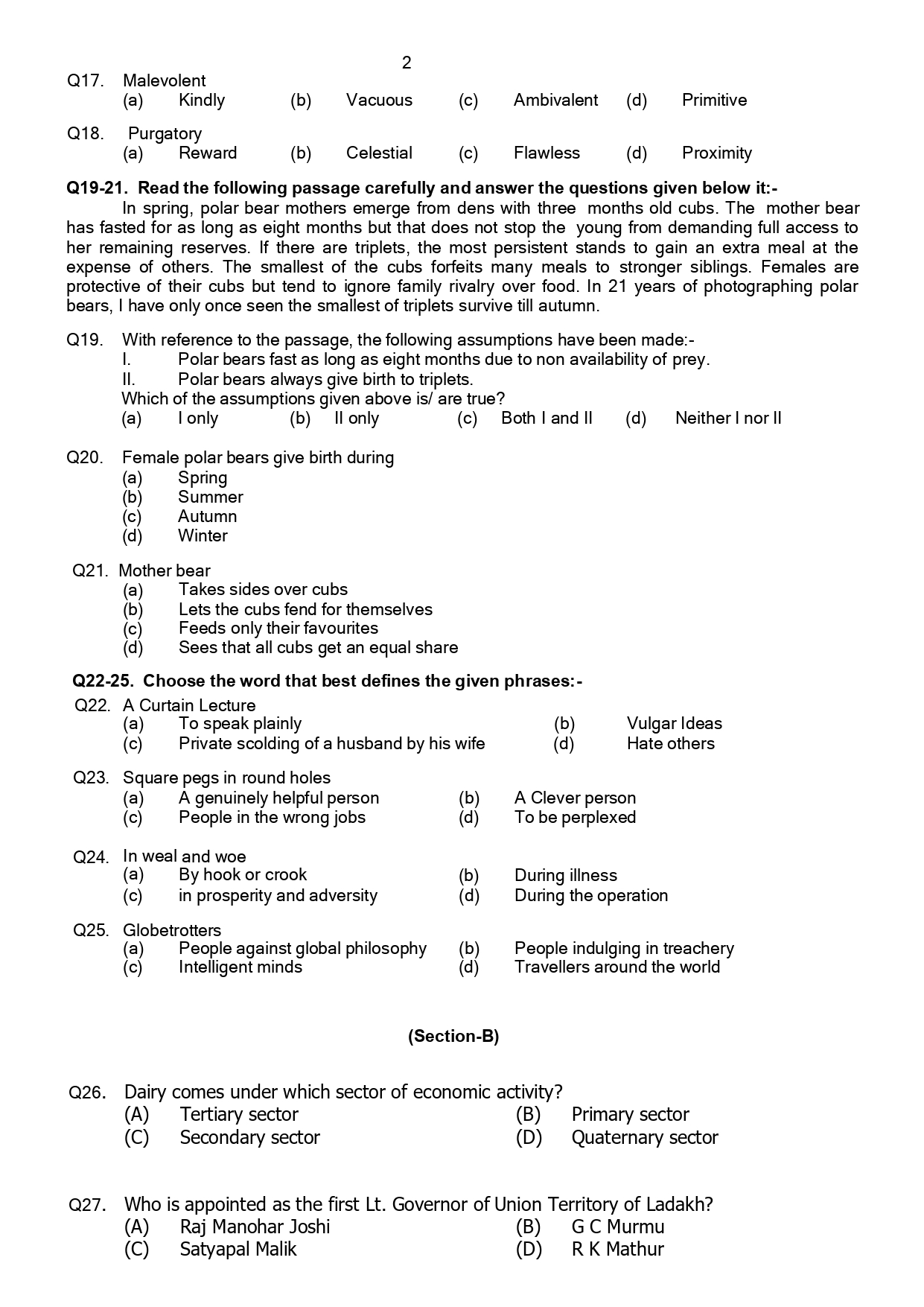


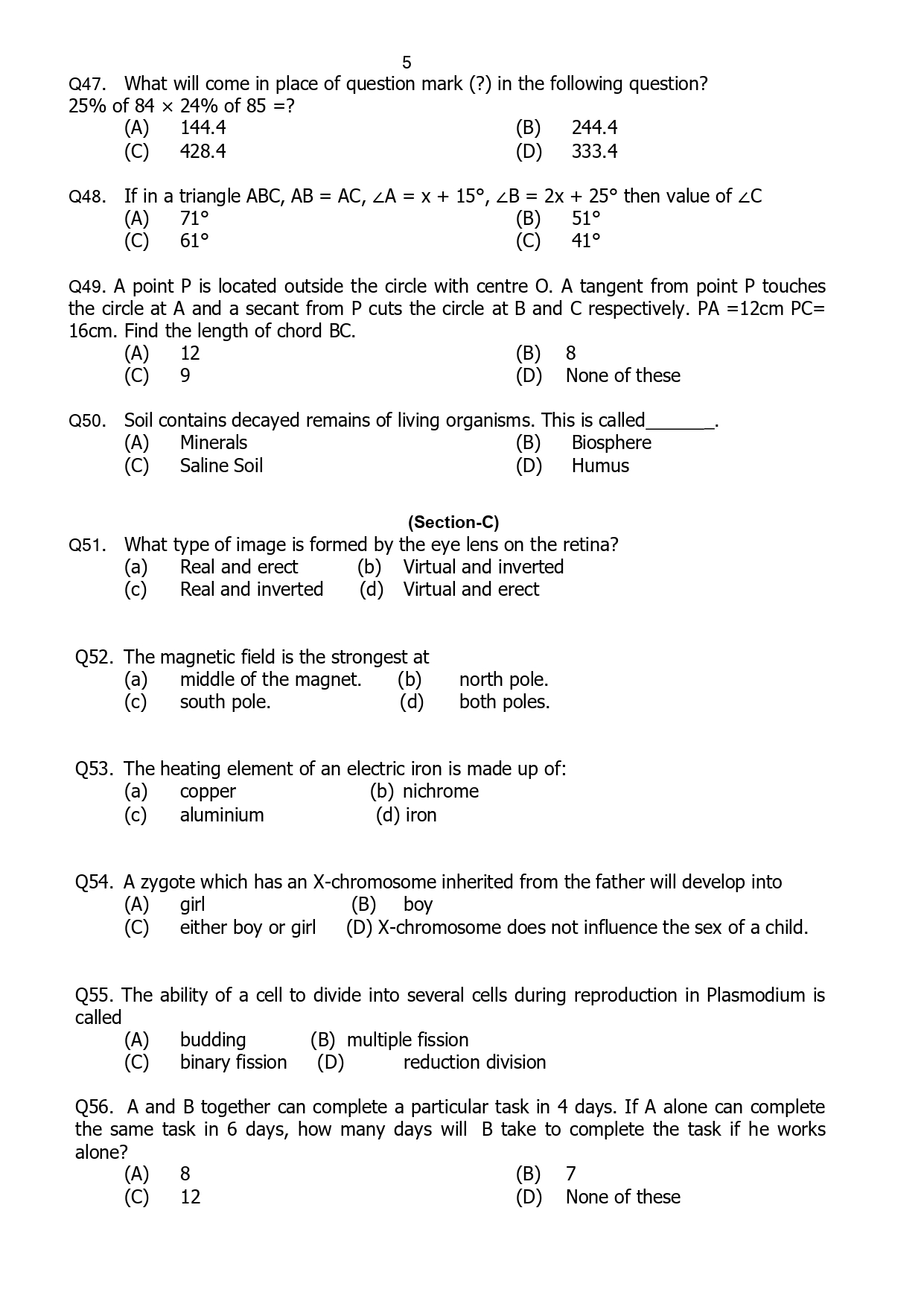

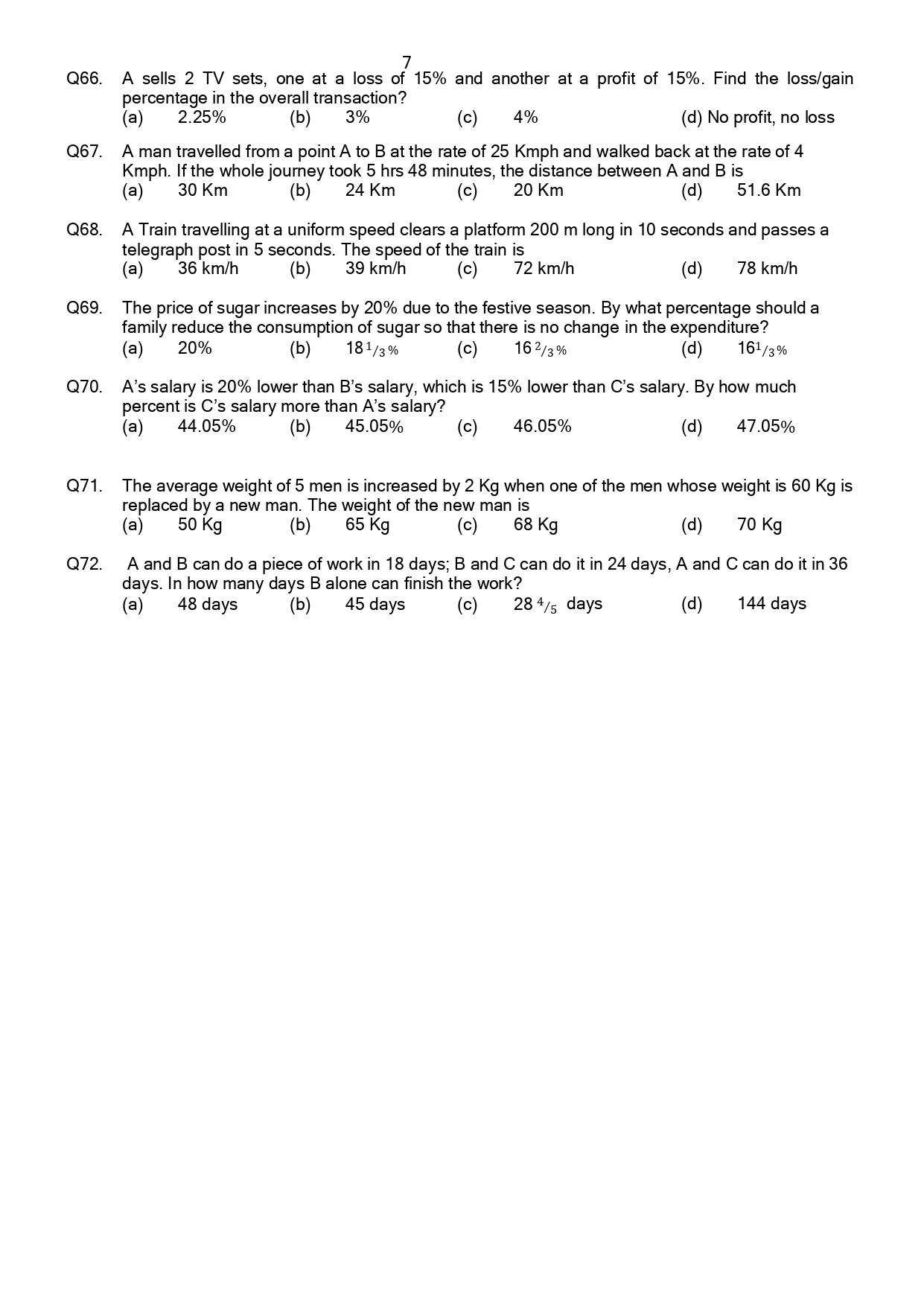
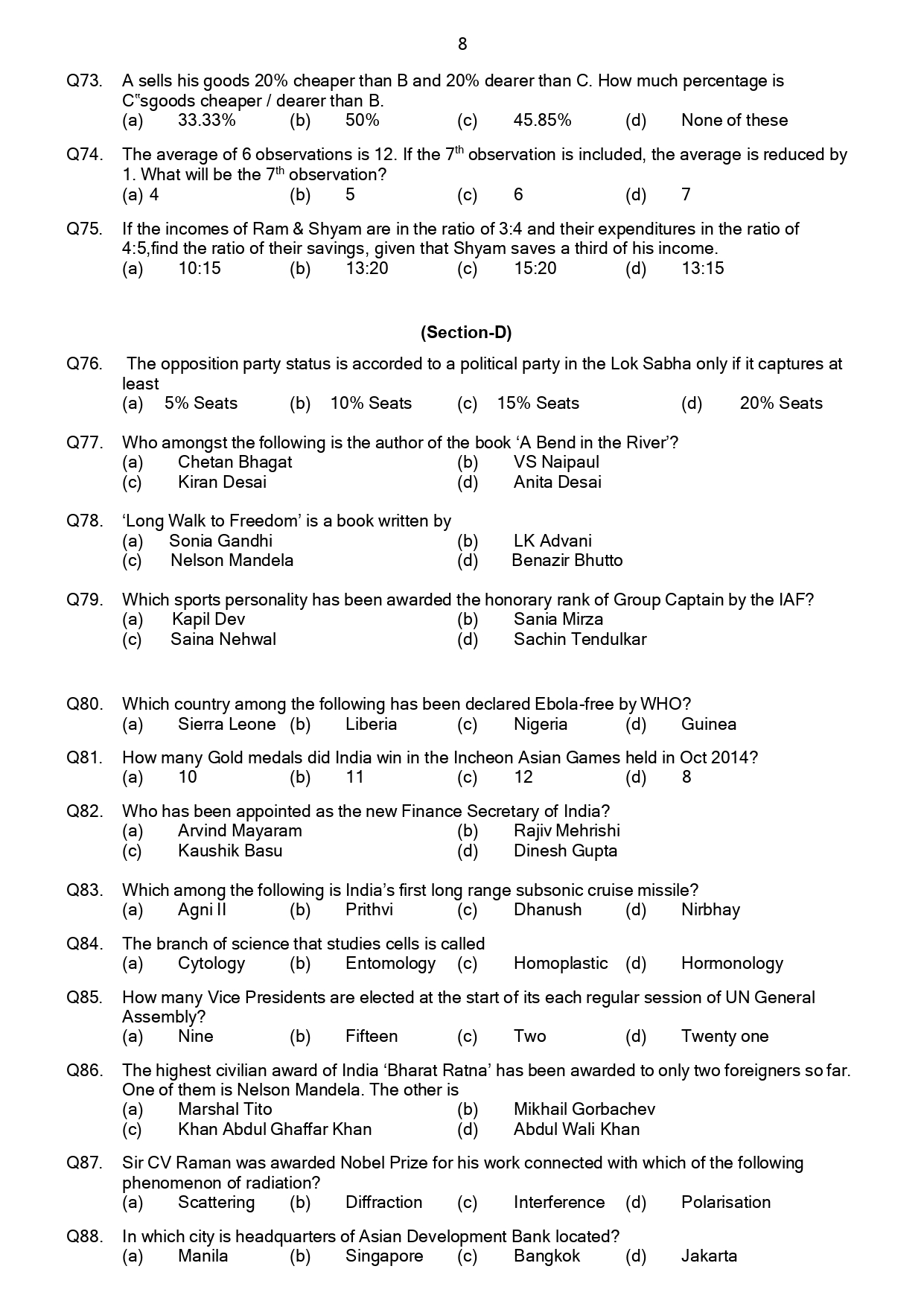

Selection Procedure
The selection of Assistant Commandant (GD) (Women)is based on all India order of merit on the performance of candidate in various stages (I-V) of CGCAT and the number of vacancies available for the post. All Candidates will be subjected for biometric, photo and document verification during various stages of recruitment. Various stages of CGCAT are as follows:-
(1) Stage-I (Screening Test)
(2) Stage-II ( Preliminary Selection Board)
(3) Stage-III ( Final Selection Board)
(4) Stage-IV (Medical examination)
(5) Stage-V (Induction)
(1) Stage-I (Screening Test)
(a) Candidates applying for Assistant Commandant (GD) (Women) will give section I of screening test, which will be a computer based examination consisting of 100 questions (4 marks for each correct answer). Stage I examination will be conducted on PAN India basis for a duration of two hours. Section I is divided into four subsections consist of English, Reasoning & Numerical Ability, General Science & Mathematical aptitude and General Knowledge. Candidate is required to pass in all subsections separately with minimum marks given below. The subjects and distribution of marks for each post is described below:-
| Subjects | No of Questions | Total Marks (400 per section) | Passing Marks | Duration |
|---|---|---|---|---|
| A: English | 25 | 100 | 200(UR/EWS/OBC)
180 (SC/ST) {50(UR/EWS/OBC) 45(SC/ST) (for each subsection)} |
2 Hrs |
| B: Reasoning & Numerical Ability | 25 | 100 | ||
| C: General Science & Mathematical aptitude | 25 | 100 | ||
| D: General Knowledge | 25 | 100 | ||
| Total | 100 | 400 |
Note:
(ii) Marking scheme will be is as follows:
(ab) One mark will be deducted for every incorrect answer.
(ac)No marks for unattempted questions.
(b) Candidate reporting for screening test will first undergo photo and biometric registration. Photo & biometric registered in stage I will be verified in subsequent stages of CGCAT.
(2) Stage-II ( Preliminary Selection Board)
Candidates shortlisted through CGCAT undergo PSB testing conducted for a day at NOIDA, Mumbai/Goa, Chennai and Kolkata centres. Candidates will be screened through Computerised Cognitive Battery Test (CCBT) and Picture Perception and Discussion Test (PP & DT). Based on grading of CCBT and PP&DT combined the candidates are recommended by the board of assessors (IO, GTO and TO) for Final Selection Board (FSB).
(3) Stage-III ( Final Selection Board)
FSB is conducted at the only Coast Guard Selection Board (CGSB) located at NOIDA and spans over five days. It is same as Selection Board of other services. The candidates are subjected to Psychological Test (Thematic Apperception Test, Word Association Test, Situation Reaction Test and Self-Description), Group Tasks (Group Discussion, Lecturette, Group Planning Exercise, outdoor Group Tasks) and Interview. Board conference is held on last day and thereafter, recommended candidates are sent for initial medical Examination.
(4) Stage-IV (Medical Examination)
(a) The candidates recommended by the FSB board/ clear stage-III will undergo a special medical examination by a Board of service medical officers at Base Hospital, New Delhi. It takes 4 to 5 days’ time to complete the special medical board (SMB). Only those candidates, who are declared fit by the SMB, will be considered for merit. Candidates declared unfit by the SMB have the liberty to undergo appeal medical board (AMB). Click here for Medical/Physical Standards acceptable in ICG.
Appeal Medical Board (AMB)
The Appeal Medical Board will be held at one of the following hospitals :-
- Base Hospital, Delhi Cantt.
- Command Hospital, Southern Command, Pune.
- Command Hospital, Eastern Command, Kolkata.
- Command Hospital, Central Command, Lucknow.
- Command Hospital, Western Command, Chandimandir.
- Command Hospital, Air Force, Bangalore.
- Command Hospital, Northern Command, Udhampur.
- INHS, Ashvini, Mumbai.
The candidates will report for medical examination within the stipulated period i.e., 42 days from the date last examined by the Special Medical Board for re-examination along with the receipted copy of the e-MRO of Rupees 40/- as directed by the President Medical Board.
Review Medical Board (RMB)
In case of candidate being declared unfit by the Appeal Medical Board, he/she may challenge the proceedings and may be granted review of medical proceedings based on the merit of the case. Any candidate desiring for a review should address the request to Director General {for Principal Directorate (Recruitment)} Indian Coast Guard with a copy to the President of Appeal Medical Board within one day of the holding of Appeal Medical Board. The application for RMB are routed to DG AFMS through DMS, CGHQ. The decision for grant of RMB is with DG AFMS, and is not a matter of right. RMBs are conducted at R&R Hospital Delhi Cantt and AFMC, Pune.
Decision of RMB will be final. No further appeal will be accepted.
(5) Stage-V (Induction)
All India Merit list will be based on combined marks of stage I (40% weightage) & FSB (60% weightage). The candidates as per select list are required to report at INA Ezhimala for 22 weeks of Naval Orientation Course (NOC).
Medical Standards
These standards are laid down to assess the fitness of a candidate for selection of Assistant Commandant (General Duty)(Women) in ICG.
1. Height, Weight And Chest
(a) Height
Only female candidate can apply for this post and minimum
height required for entry into Indian Coast Guard for male
candidate is 152 cm.
Note:
(ii) And upto 2 cm in case of candidates from Lakshadweep.
(b) Weight
The minimum acceptable weight that candidate of a particular
age and height must have is tabulated below. These weights
are based on BMI.
Table 1. - Height / Weight standards for Female candidate (in kgs)
| Height in Cms | AGE IN YEARS | |||||||||
|---|---|---|---|---|---|---|---|---|---|---|
| 17-18 | 20 | 25 | 30 | 35 | 40 | 45 | 50 | 55 | 60 | |
| 148 | 36 | 38.5 | 41 | 42.5 | 44 | 45 | 46.5 | 47 | 48.5 | 49 |
| 150 | 38.5 | 40.5 | 41.5 | 43.5 | 45 | 46 | 47 | 48 | 49 | 50 |
| 153 | 40.5 | 42 | 43.5 | 45.5 | 46.5 | 48 | 48.5 | 49.5 | 50.5 | 52 |
| 155 | 42 | 43 | 44.5 | 46 | 47.5 | 49 | 49.5 | 50 | 51.5 | 52.5 |
| 158 | 43 | 45 | 46.5 | 48 | 49.5 | 50.5 | 51.5 | 52 | 53 | 54.5 |
| 160 | 45 | 46 | 47.5 | 49 | 50.5 | 51.5 | 52.5 | 53 | 54 | 56.5 |
| 163 | 46 | 47.5 | 49 | 50.5 | 51.5 | 52.5 | 53 | 54 | 55.5 | 56.5 |
| 165 | 47.5 | 49 | 51 | 52 | 53 | 54 | 55 | 56 | 57 | 58 |
| 168 | 49 | 50 | 52 | 54 | 55.5 | 57 | 58 | 59 | 60 | 61 |
| 170 | 50 | 51 | 53 | 55 | 56 | 58 | 59 | 60 | 61 | 62 |
| 173 | 52 | 53 | 55 | 56 | 57 | 59 | 60 | 61 | 62 | 63 |
| 175 | 53.5 | 55 | 56.5 | 57.5 | 59 | 60.5 | 62 | 63 | 64 | 65 |
Note:
(ii) Certain athletic individuals like wrestlers or bodybuilders may exceed the prescribed weight limit because of bigger muscle mass. In such individuals, assessment will be made of subcutaneous fat. For this purpose skin fold thickness of more than 23mm in males will be taken as indicative of obesity. If there is no excess of adipose tissue, such individuals will be considered fit. However in doubtful cases the opinion of Medical Specialist must be sought.
(i) Should be well proportioned without deformity of chest, congenital or acquired.
(ii) Expansion not less than 5 cms.
(iii) Absence of significant gynaecomastia in males, bilateral or unilatera.
2. Eyes
Visual standard acceptable for Assistant Commandant (GD) in ICG is as follows:-
| Uncorrected without glass | Corrected with glass | Limit of Myopia | Limit of Hypermetropia | Binocular Vision | Limit of Colour Perception |
|---|---|---|---|---|---|
| 6/6 6/9 |
6/6 6/6 |
-0.75 | +1.5 | Ⅲ | Ⅰ |
Note:
(b) Distant Vision - Candidates who do not qualify the distant vision standard (uncorrected without glass) will be declared unfit even if their other eye standards are within normal limits.
(c) Wearing of Spectacles - Spectacles are permitted in all branches, even at the time of entry, except GD branch prior to completion of initial training. The glasses should not have a tint darker than A2 tint.
(d) Wearing of Contact Lenses - Contact lenses are permitted in all branches. However, the responsibility for their procurement, maintenance and for any complications resulting from their use, rests entirely on the individual. Exceptions are as (c) ibid.
(e) Muscle Balance -
(ab) Hyperphoria not to exceed one prism dioptres.
(ab) Exophoria 16 prism dioptres.
(ac) Hyperphoria one prism dioptres.
(f) Ocular movements must be full in all directions and the pupils should react normally to light and accommodation. Manifest squint is a cause for rejection.
(g) Visual Fields - The Visual fields in each eye must be full as tested by confrontation method.
(h) Standard of colour Perception - As reflected in the table for each branch and to be tested by MLT at a distance of 6M (20 feet). Test by Ishihara/Tokyo Medical College Book Test with no error.
(i) Laser therapy for correction of Myopia is not acceptable.
(j) Standard for Night Vision Acuity(NVA) -
(ii) Night Vision acuity is to be tested only if there is a history of congenital night blindness in the family or where there is a suspicion of night blindness in the candidate. In other cases, an assertion by the candidate (applicable only to candidates for GD branch) that neither he nor any of his family members suffers from congenital night blindness, will suffice.
(l) Other causes for Rejection -
(ii) Xeropthalmia.
(ii) Pterygium.
(iv) Medial Opacities.
(v) Abnormal pupillary reactions.
3. Ear, Nose and Throat
History of recurrent ear ache, tinnitus or vertigo, impairment of hearing, disease of the external meatus including atresia, exostosis or neoplasm which prevent a thorough examination of the drum, unhealed perforation of the tympanic membrane, aural discharge or sign of acute or chronic suppurative otitis media, evidence of radical or modified radical mastoid operation, are a cause for being unfit.
Note:
(ii) Even though when the ear is healthy, the tympanic membrane is intact and freely mobile, and there is no defective hearing on audiometry, but if the candidate has undergone a cortical mastoid operation, a successful myringoplasty or tympanoplasty, the candidate is to be rejected.
Disease of the bones or cartilages of the nose, marked nasal allergy, nasal polyps, atrophic rhinitis, disease of the accessory Sinuses and nasopharynx are causes for rejection.
Note:
(c) Throat
Disease of throat, palate, tongue, tonsils, gums and disease or injury affecting the normal function of either mandibular joints should be absent.
Note:
(d) Disease of the larynx and impediment of speech should be absent
Note:
4. Neck
(a) Disease of the thyroid gland is a cause for rejection.
(b)
Enlarged glands, tubercular or due to other diseases in the
neck or other parts of the body are a cause for rejection.
Note:
5. Skin and Sexually Transmitted Disease (STD)
A candidate should not have:-
(a) Skin disease unless temporary or trivial.
(b)
Scars which by their extent or position cause or are likely
to cause disability or marked disfigurement.
(c)
Hyperhydrosis palmar, plantar, or axillary.
(d)
Congenital, active or latent sexually transmitted diseases.
Note:
6. Respiratory System
A candidate should not have:-
(a) History of chronic cough or bronchial asthma are cause
for rejection.
(b) Evidence of pulmonary tuberculosis
is a cause for rejection.
(c) Evidence of diseases of
bronchi, lungs or pleurae detected on radiological
examination of the chest will disqualify the candidate.
7. Cardio-Vascular System
A candidate should not have:-
(a) Functional or organic disease of the heart or blood
vessels, presence of murmurs or clicks on auscultation.
(b) Tachycardia (Pulse Rate persistently over 96/min at
rest), bradycardia (Pulse Rate persistently below 40/min at
rest), any abnormality of peripheral pulses.
(c) Blood
pressure exceeding 140mm Hg systolic or 90 mmHg diastolic.
8. Abdomen
A candidate should not have:-
(a) Evidence of any disease of the gastro-intestinal tract.
Enlargement of liver, gall bladder or spleen, tenderness on
abdominal palpation, evidence/history of extensive abdominal
surgery.
(b) Fistula in ano, anal fissure, or
hemorrhoids, unless satisfactory treatment has been carried
out.
(c) Inguinal or any other hernia or tendency
thereto.
Note:
Those who have been operated for hernia/hydrocele, varicose-veins, vericocele may be declared fit provided:
(i) Six months have elapsed since the operation for hernia
and six weeks for other operations. Documentary proof to
this effect is to be produced by the candidate.
(ii)
General tone of the abdominal musculature is good.
(iii) There is no recurrence of hernia or any other
complication connected with the operation.
9. Genito-urinary system
A candidate should not have:-
(a) Any evidence of defect/disease of genital organ,
hydrocele, varicocele.
(b) Disease or malformation of
the kidneys or urethra.
(c) Incontinence of Urine,
nocturnal enuresis.
(d) Any abnormality on examination
of urine including albuminuria or glycosuria.
(e)
Bilateral undescended testis, Unilateral undescended testis,
retained in the inguinal canal or at the external abdominal
ring unless corrected by operation.
Note:
Absence of one testis is not a cause for rejection unless the testis has been removed on account of disease or its absence has affected the physical or mental health of the candidate.
10. Central Nervous System
(a) Organic disease of Central Nervous System is not
acceptable.
(b) Tremors, not acceptable.
(c)
Candidates with history of fits or recurrent attacks of
headache/migraine will not be accepted.
11. Psychiatric Disorders
History or evidence of mental disease or nervous instability in the candidate or his family not acceptable.
12. Women Candidates
They should not be pregnant and should also be free from any gynecological disorder such as primary or secondary Amenorrhoea / Dysmenorrhoea / Menorrhagia.
13. Dental Condition
It should be ensured that a sufficient number of natural and sound teeth are present for efficient mastication. Teeth not considered necessary for efficient mastication are allotted one point each, and those essential two points each.
(a) Dental points less than 14 are a cause for rejection. A
candidate must have a minimum of 14 dental points to be
acceptable in order to assess the dental condition of an
individual, points are allotted as under for teeth in good
apposition with corresponding teeth in either jaw.
(i) Central incisor, lateral incisor, canine, 1stPremolar,
2nd Premolar and under developed third molar- one point
each.
(ii) 1st molar, 2nd molar and fully developed
3rdmolar - 2 points each.
(ii) When all 32 teeth are
present, there will be a total count of 22 or 20 points
according to whether the third molars are fully developed or
not.
(b) The following teeth in good functional apposition must be
present in each jaw:
(i) Any 4 of the anteriors.
(ii) Any 6 of the 10
posteriors.
(iii) All teeth must be sound/repairable.
(c) Candidates suffering from severe pyorrhoea will be rejected. When the state of pyorrhoea is such that in the opinion of the dental officer, it can be cured without extraction of teeth, the candidates may be accepted. A note about the affected teeth is to be inserted by the dental officer in the medical documents(AFMSF-2A).
(d) Artificial dentures are a cause for rejection, however
ex-servicemen, deputationists, and those seconded from other
Government departments having well fitted dentures may be
accepted except divers.
14. Major Defects for Rejection are as under
(a) Weak constitution, imperfect development, congenital
malformation, muscle wasting.
Note:
Wasting is to be judged entirely by its effect on function.
(b) Malformation of the head including deformity from
fracture or depression of the bones of the skull.
(c)
Disease or abnormal curvature of the spine. Scoliosis more
than 10 by Cobb's method in less than 25 years of age,
and 15 in more than 25 years of age. X-Ray of spine may be
done on the advice of the appropriate specialist.
(d)
Skeletal deformity either hereditary or acquired, and disease
or impairment of function of bones or joints.
Note:
Rudimentary cervical rib causing no signs or symptoms is acceptable.
(e) Asymmetry of torso or limbs, abnormality of locomotion
including amputation.
(f) Deformity of feet and toes.
15. Acceptable Defects on Entry
Candidates for the Coast Guard with the following minor
defects may be accepted. These defects are however to be
noted in the medical forms on entry.
(a) Knock knees with a separation of less than 5 cm at the
internal malleoli.
(b) Mild curvature of legs not
affecting walking or running Intercondylar distance should
not be over 7 cm.
(c) Mild hammer toe and minor degree
of hallux valgus.
(d) Flexible flat feet with no
significant history of pain.
(e) Healed perforation of
the ear drum without any discontinuity is acceptable,
provided the hearing is normal.
(f) Mild stammering
not affecting expression.
(g) Mild degree of
varicocele.
(h) Mild degree of varicose veins.
(j) The carrying angle of elbow should not be more than10
degrees for male candidate and 15 degrees for female
candidates.
Note:
Remedial operations where ever required are to be performed
prior to entry. No guarantee is given of ultimate acceptance
and it should be clearly understood by a candidate that the
decision whether an operation is desirable or necessary is
one to be made by his/her private medical advisor, The
Government will accept no liability regarding the result of
operation or any expenses incurred.
(k) Any other slight defect which produces no functional
disability and which in the opinion of the medical
officer/medical board will not interfere with the individuals
efficiency as an officer or enrolled personnel.
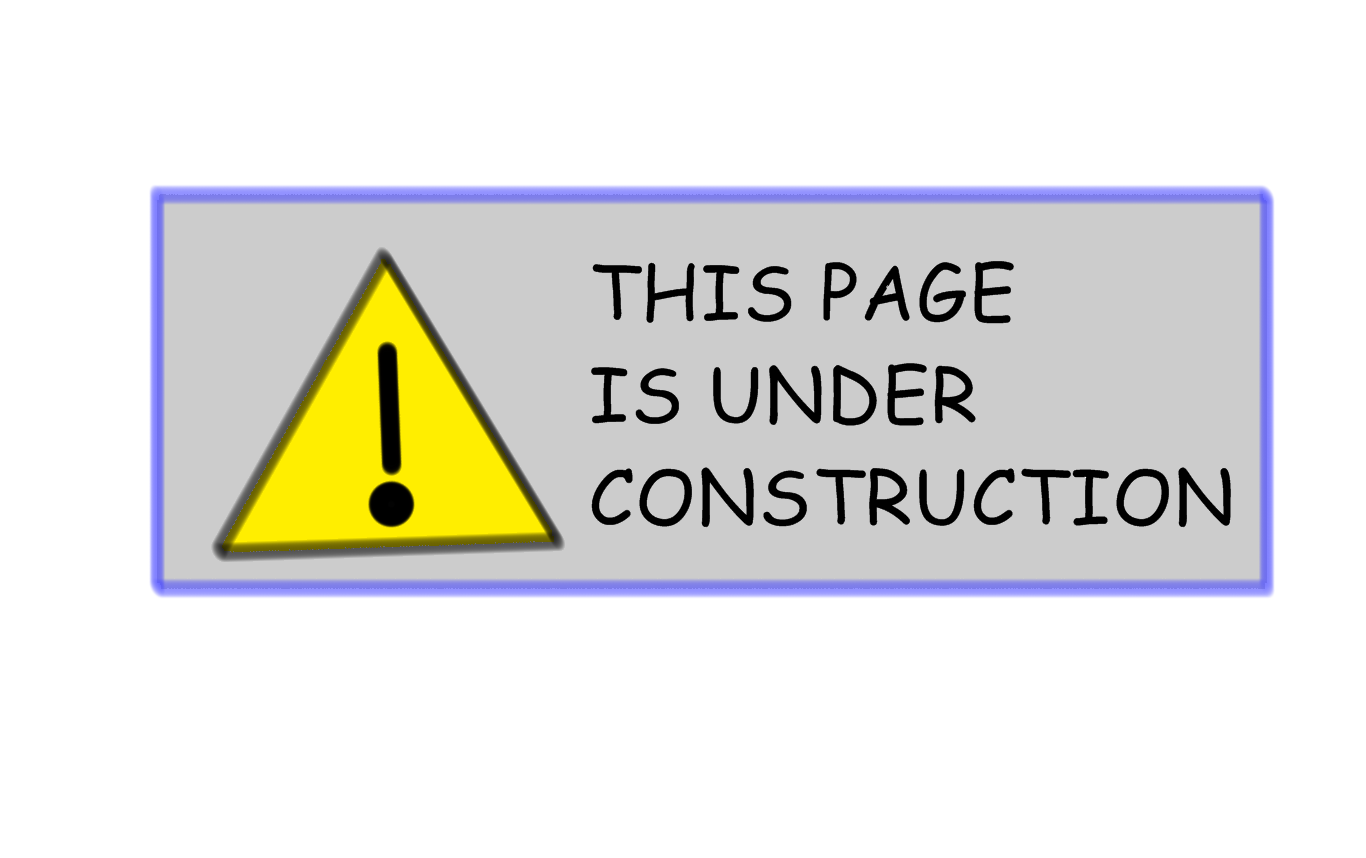
Recruitment Cycle
The recruitment of Assistant Commandant will be conducted twice in a year for Batch commencing at Indian Naval Academy during the month Jun & Dec. The exact schedule of recruitment shall be decided by the Coast Guard Headquarters keeping in view the training schedule and other administrative requirements. However, the tentative schedule for two cycles is as follows:-
| Event | CGCAT 1st Batch | CGCAT 2nd Batch |
|---|---|---|
| Publication of Advertisement | Jan/Feb | Jun/Jul |
| Registration | As per advertisement | As per advertisement |
| Download Admit Card | As per advertisement | As per advertisement |
| Stage-I Online exam (Screening test) | As per advertisement | As per advertisement |
| Stage-II (PSB) | Jun | Jan |
| Stage-III (FSB) | Jul-Oct | Feb-May |
| Stage-IV (Medicals) | Jul-Dec | Feb-Jun |
| Issue of Appointment Letter | Dec | Jun |
| Induction at INA | End Dec | End Jun |
Note:
The
advertisement for the above recruitment cycle is generally
published as follows:
- First Batch Cycle- Jan/Feb
- Second Batch Cycle- Jun/Jul
Training
The basic training for Assistant Commandant (General Duty) – Women Short Service Appointment (SSA) will be conducted at Indian Naval academy followed by ab-initio training at various training establishments/ units/ ships of Indian Navy and Indian Coast Guard.
Duration of Training
22 weeks
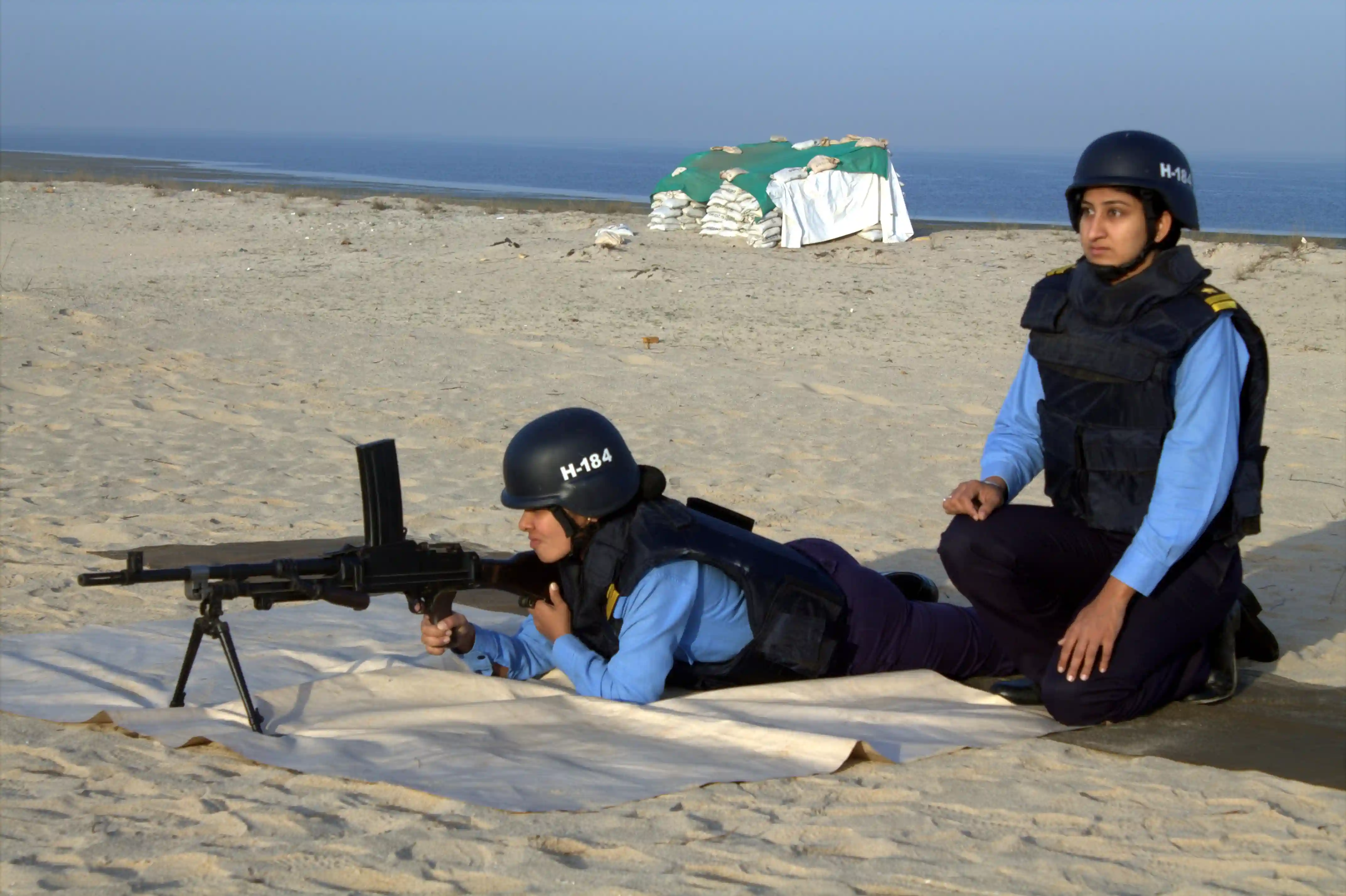
Pay and Allowances
| Rank | Pay |
|---|---|
| Navik (Domestic Branch) | Basic Pay Scale for Navik (DB) is 21700/- (Pay Level-3) plus Dearness Allowance and other allowances based on nature of duty/place of posting as per the prevailing regulation. |
Note: Pay and Allowances are subject to change as per government directives issued from time to time.
Benefits
- Free ration and clothing as per the existing rules. Free medical treatment for self and family including dependent parents.
- Government accommodation for self & family on nominal license fee.
- 45 days Earned leave and 08 days Casual leave every year with Leave Travel Concession (LTC) for self, family and dependent parents as per Government rules.
- Contributory Pension Scheme and Gratuity on retirement.
- Canteen and various loan facilities.
- ECHS medical facilities after retirement.
- Insurance cover (on contribution) of Rs. 50 lakhs for Enrolled Personnel is applicable.
Note: Benefits are subject to change as per government directives issued from time to time.
Career Progression
Officer’s joining ICG as Assistant Commandant get optimum career progression opportunity for further promotion to the higher ranks. The rank structures and required minimum time period for promotion to next higher rank for Assistant Commandant (General Duty) – Women Short Service Appointment (SSA) is as follows:
Rank Structure
Commandant (JG)
Deputy Commandant
Assistant Commandant
Assistant Commandant (Under Probation)
| Rank | Minimum time period in one rank for promotion |
|---|---|
| Assistant Commandant (Under Probation) - Assistant Commandant | 2 Yrs |
| Assistant Commandant - Deputy Commandant | 6 Yrs |
| Deputy Commandant - Commandant (JG) | 11 Yrs |
Note: Promotion rules are subject to change as per government regulations in vogue.
Job Profile
Women officers are appointed as Assistant Commandant in General Duty (GD) branch on Short Service Appointment for a period of 8 years. This tenure is further extendable up to 10 years and then up to 14 years. Women Officers operates Air Cushion vessels (ACV) and carry out various duties for efficient running of the organization at ashore billets.
